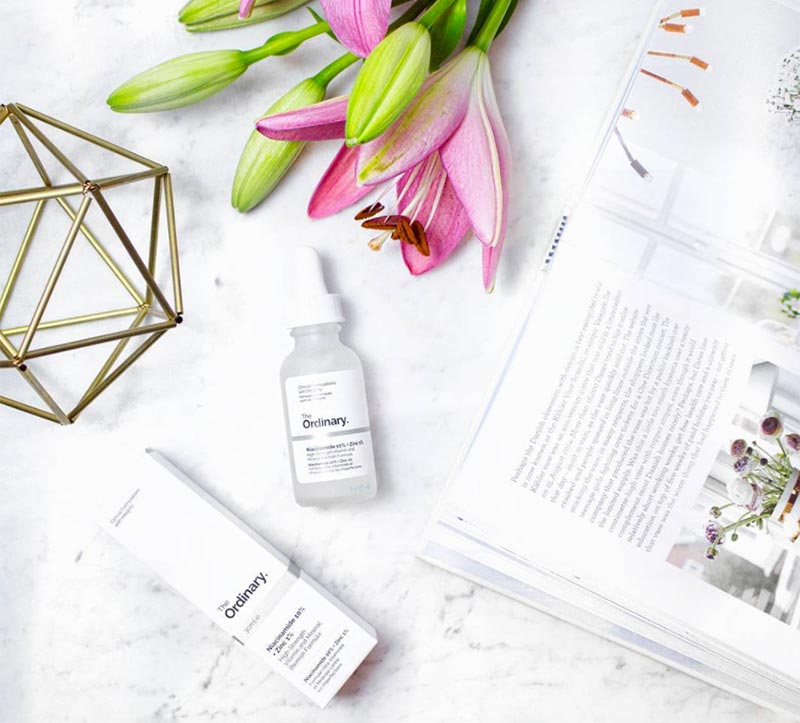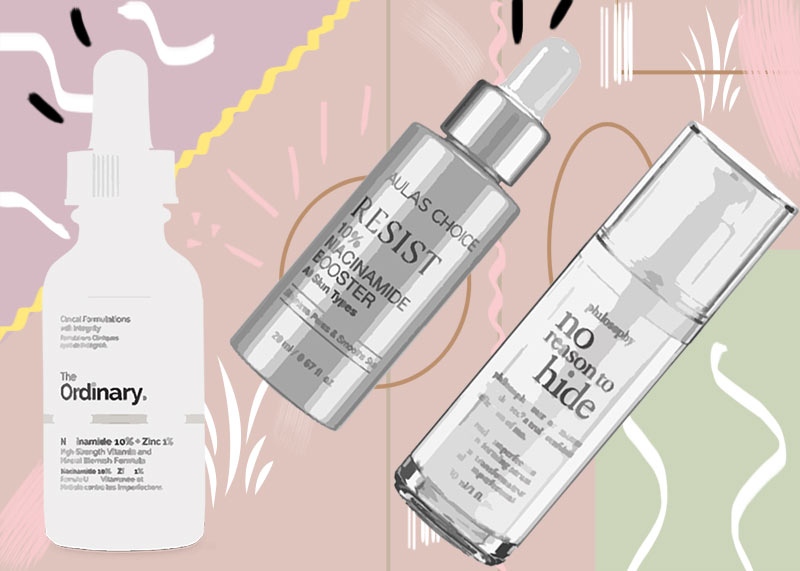Niacinamide is the magical ingredient that does it all. If you haven’t heard about it yet, it is time to tune in, because this wonderful active ingredient belongs in almost every skincare routine.
In this comprehensive guide to niacinamide for skin, we will give you the complete lowdown. You will learn exactly what niacinamide is, and how it works for different skin concerns. We will give a thorough explanation of how you should use niacinamide along.
In this article:
- What Is Niacinamide?
- Niacinamide Benefits for Your Skin
- How Does Niacinamide Work?
- Are There Any Side Effects to Using Niacinamide?
- How to Use Niacinamide
- How Long to Use Niacinamide Until I See Results?
- Does Niacinamide Work with Vitamin C?
What Is Niacinamide?
In the skin care world, niacinamide is an antioxidant, also known as vitamin B3 or nicotinic acid. It occurs naturally in our bodies, as well as in a ton of the food we eat, including most meats, fish, and many healthy, dark green veggies.
Niacinamide is responsible for all kinds of healthy body functions, and is essential for our brain, digestive system, and nervous system.
Niacinamide Benefits for Your Skin
Niacinamide is an exceptional skincare ingredient because it can treat nearly any skin concern. It is an effective treatment for the following issues:
- Acne and breakouts
- Hyperpigmentation and dark spots
- Scarring
- Uneven skin texture
- Oversized pores
- Redness and sensitivity
- Compromised skin barrier, which looks like itchy, flakey, or overly thin skin
- Premature aging, especially fine lines and loss of tone
- Overproduction of oil
- Dullness and sallowness
How Does Niacinamide Work?
Is beautifully a good answer? I guess not. Niacinamide works in a variety of ways, some of which are better understood than others.
In order to be effective, the amount of niacinamide in your product has to be significant. Between 10% and 2% will usually be enough for noticeable results. Looking at the ingredients list of a product, you want some form of niacinamide to be one of the first 5 ingredients listed.
The way niacinamide works for preventing premature aging is quite simple – this ingredient is an antioxidant that blocks the free radical damage caused by sun exposure and pollution. Niacinamide is best paired with other antioxidants, like vitamin E, vitamin C, and a variety of natural plant oils and extracts.
Mature skin, along with dry, sensitive, and compromised skin, will also benefit from niacinamide’s skin restoring properties.
Niacinamide has been shown to improve the skin’s barrier functions by increasing cell turnover and proliferation, as well as lipid production, all of which make the skin better able to retain moisture, heal itself, and combat irritants. These same properties also mean that the look of fine lines and wrinkles will be reduced, and redness is also very likely to fade.
Niacinamide helps minimize the look of dark spots and hyperpigmentation as well. As an anti-inflammatory ingredient, niacinamide helps reduce the redness and swelling that is so characteristic of active acne, as well as rosacea and other sensitive skin conditions.
This anti-inflammatory effect also helps prevent acne from becoming severe in the first place, so it is a good addition to a skincare routine that already includes anti-bacterial agents like benzoyl peroxide.
I’m unsure exactly how this last one occurs, but many loyal users of niacinamide along with some scientific studies reported that overproduction of oil in their skin was reduced when they started using niacinamide regularly. This is especially incredible, since niacinamide does all of that without drying out the skin or compromising its ability to retain moisture – quite the opposite!

Are There Any Side Effects to Using Niacinamide?
For the most part niacinamide is a very safe choice, and it tends to cause less side effects than other skincare ingredients that are used for the same skin concerns.
However, those with very sensitive skin might notice that their skin does become red or irritated when they use niacinamide. If that happens to you, you can try to reduce how often you apply niacinamide to your skin, or you can switch to a product with a lower percentage of niacinamide. If that doesn’t work, discontinue use.
Some people do have allergies to niacinamide, as can happen with any other skincare ingredient. That is why patch testing any new product you may introduce to your routine is very important. If you notice persistent itchiness, redness, or bumps, discontinue use.
It is not very common, but some people do break out after using niacinamide. If, after a few weeks, you are still breaking out from using niacinamide, it is best to stop and try a different acne treatment.
How to Use Niacinamide
The beautiful thing about niacinamide is that it is a fairly stable skincare ingredient that can fit into one’s skincare routine at almost any stage, in a bunch of different forms. For example, if you like a speedy, easy 2-step routine, you can simply switch to a moisturizer that contains a significant amount of niacinamide.
The second you opt for a more involved skincare routine, there are a few ways to incorporate niacinamide.
The beautiful thing about this ingredient is that, unlike many other actives, it does not make the skin extra sensitive to sun exposure, and can be safely used both during the day and in the evening.
Since niacinamide requires a relatively high pH (at least compared to other ingredients) in order to work well, it is better to use at a later stage in your routine. A more involved evening skincare routine using niacinamide, for example, would look like this:
- Cleanse the skin thoroughly with a face wash of your choice.
- Tone with a pH-balancing, alcohol-free toner.
- Apply low-pH active ingredients, like chemical exfoliants, azelaic acid, and vitamin C.
- After your pH-dependant actives, you can basically apply your niacinamide at any point. If it is in a more liquid based formula, apply it next. If it is a thicker serum or cream, apply your thinner niacinamide serums first.
- Finish off with your heaviest cream or balm, and enjoy a restful sleep!
A morning skincare routine with niacinamide could look the same, with the addition of a final sunscreen step. I also think that cleansing is not mandatory in the mornings, and that in general, it is better to not overdo steps in the morning.
How Long to Use Niacinamide Until I See Results?
Unlike more aggressive skin treatments like retinol or acid peels, niacinamide takes its time to produce results. This also means that niacinamide is more gentle on the skin, and is less likely to cause irritation or thin it out.
There were many studies done to see the effects of niacinamide over time, to treat various skin concerns. A 5% niacinamide solution was able to improve the look of wrinkles, pigmentation, sagging skin, and other signs of premature aging, after 12 weeks of regular application.
Another study tested the effect of niacinamide on acne, and it showed a significant reduction on 80% of the subjects after 8 weeks. In other words, take your time with it, and be patient, because you’re looking at least a two months of consistent use of niacinamide before you can expect really noticeable results.
Does Niacinamide Work with Vitamin C?
You might want to be careful combining vitamin C serums with niacinamide products. While the two active ingredients are perfectly safe together (and they, in fact, boost each other’s efficacy), using them at the exact same time can cause a flush to the skin.
That red flush normally goes away after 20 minutes or so, but if you want to avoid them altogether, simply use one in the morning and another in the evening. Since vitamin C can boost the effects of sunscreen, it is usually the better choice for the morning routine.
Have you tried using niacinamide before? How did it work for you? Are you thinking of trying it? Let us know!
Photos via Sephora, Nordstrom





